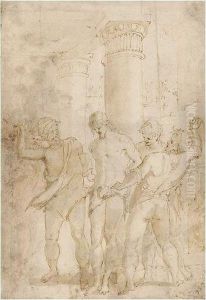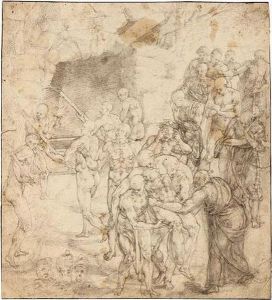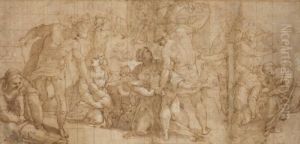Niccolo Circignani Il Pomarancio Paintings
Niccolò Circignani, known as Il Pomarancio, was an Italian painter of the late Renaissance or Mannerist period. He was born in Pomarance, a town in the province of Pisa, Tuscany, in 1530. Il Pomarancio is a nickname referring to his place of origin, much like many artists of the time were named for their native towns or regions. His work was primarily influenced by the prevailing Mannerist style, which was characterized by artificiality, grace, and elegance over the more naturalistic style of the High Renaissance.
Circignani trained in Rome, where he was influenced by the work of Michelangelo, Raphael, and their followers. His painting was known for its use of vivid colors, elongated figures, and often complex compositions. Il Pomarancio was particularly adept in fresco painting, which formed the bulk of his oeuvre. He was involved in various significant projects in Rome, including works in the Vatican under Pope Pius V.
In the later phase of his career, Il Pomarancio's work took him outside Rome to places like Orvieto and Spoleto. His works outside Rome often involved collaborating with other artists or completing extensive fresco cycles in churches and cathedrals. These works often depicted scenes from the Bible and the lives of saints, which were typical subjects of the Counter-Reformation period when the Catholic Church emphasized religious art that was clear, instructive, and inspirational to counter the Protestant Reformation.
Niccolò Circignani's legacy includes contributions to the decoration of the Orvieto Cathedral and the frescoes in the Cathedral of Spoleto, which are considered some of his masterpieces. His work is also present in various churches in Umbria and Lazio. Il Pomarancio died in 1597, leaving behind a body of work that contributes to our understanding of Mannerist painting in late Renaissance Italy.


